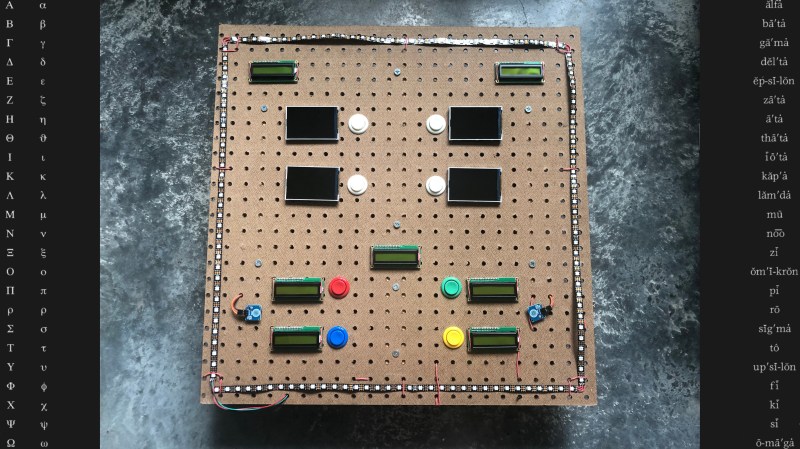Learning a new language is hard work, but they say that the best way to learn something is to teach it. [Angeliki Beyko] is learning Greek, and what better way to teach than to build a vocabulary flash-card game from Arduinos, color screens, 1602 text screens, and arcade buttons? After the break, we have a video from the creator talking about how to play, the hardware she chose, and what to expect in the next version.
Pegboard holds most of the hardware except the color screens, which are finicky when it comes to their power source. The project is like someone raided our collective junk drawers and picked out the coolest bits to make a game. Around the perimeter are over one hundred NeoPixels to display the game progress and draw people like a midway game. Once invested, you select a category on the four colored arcade buttons by looking at the adjacent LCD screens’ titles. An onboard MP3 shield reads a pseudo-random Greek word and displays it on the top-right 1602 screen in English phonetics. After that, it is multiple choice with your options displaying in full-color on four TFT monitors. A correct choice awards you a point and moves to the next word, but any excuse to mash on arcade buttons is good enough for us.
[Angeliki] does something we see more often than before, she’s covering what she learned, struggled with, would do differently, and how she wants to improve. We think this is a vital sign that the hacker community is showcasing what we already knew; hackers love to share their knowledge and improve themselves.
Typing Greek with a modern keyboard will have you reaching for an alt-code table unless you make a shortcut keyboard, and if you learn Greek, maybe you can figure out what armor they wore to battle.
















Cool! Would be fun to adapt it for what I’m working on (Spanish, Czech and ASL). Did write a Python program for ASL, but hardware is a better challenge.
I don’t know if you realize how impressive all that good work is! Coordinating the Arduinos, the software, making it all work, and mostly just sticking to the job to get it working are all wonderful. It takes a lot to go from a bare idea to actually making something. Everyone (I exaggerate) has ideas, but few people follow through. Bravo!
Creative design. Proven Arcade styling with tactile switching. I like to mash buttons too. Bigger the better. Cola machine size windowed selector buttons more so.
Press the right buttons. Get my prize: Cola. Chips. High score Name on top of the List. Bells. Whistles. Fireworks. Something. Then there’s getting it wrong and what level of negative response is required. Simple correction or repulsive rejection. Maybe electroshock therapy.
I didnt see much of prize/reward system. Passing grade on exam. Phfttt! What eeee ver.
Instant gratificAtion please.
Overall great work. Can be easily modified for other Language and game play. Awesome.
Whining:
Alligator clips. -Tack solder speaker wire if dont have crimps.
Protoboards for jump points. -Barrier strips , tie point strips, or ‘woodscrews and washers’ likely more reliable especially if combined with pre-form wire.
.pre-formed proto wires – These are shot out like bullets from Gatling gun. Almost no Qaulity Control. Expect three out of fifty to fail continuity right out from the wrapper. Ratio based on luck of draw. Few more to go useless when stressed. I like them too but classic 20-24 awg solid copper wire on a roll is cheap, hold better in the protoboards, make any length (bus), not likely to fail continuity. Automatic wire stripper a plus and expense. Try not to get caught up in the expensive crimped connector game.
This is a re-visit. I know this is an old project, but I still think it is quite an accomplishment.